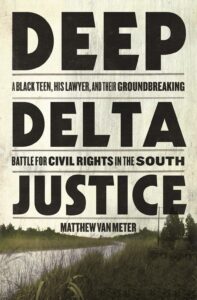Summer 2021
Defying Injustice in the Deep South
Deep Delta Justice by Matthew Van Meter
Published: May 28, 2021
Last Updated: August 31, 2021

Little, Brown and Company
The book opens on the afternoon of October 18, 1966, as a young Black man named Gary Duncan is driving home to Boothville-Venice from a weeklong shift working on a tugboat on the Mississippi River. He stops his car when he sees two Black boys, whom he recognizes as his nephew Bert Grant and cousin Bernard St. Ann, with four white boys on the side of the highway. Feeling uneasy, Duncan gets out of the car and tells Grant and St. Ann to get in. One of the boys, Herman Landry, engages Duncan, asking him if he could read before whispering a racial slur. Duncan responds, “You’d best run along home now,” as he gently touches Landry’s arm, ending the exchange. Little did Duncan know that this gesture would mark “the beginning of one of the most important—and improbable—criminal cases in American history.”
At the height of the civil rights era, lawyers from across the country moved south to defend activists and help dismantle an unjust legal system. One such lawyer was Richard Sobol. The twenty-nine-year-old was working at the corporate firm Arnold, Fortas, and Porter in Washington, DC, when he heard Martin Luther King Jr.’s “I Have a Dream” speech on the radio. The speech compelled him, as a white man, to seek greater meaning in his professional work. In 1965 he took a leave of absence from his firm and moved to New Orleans to work for the Lawyers Constitutional Defense Committee (LCDC), which was housed in the office of the Black-owned firm Collins, Douglas, and Elie. Carl Rachlin, the general counsel for the Congress of Racial Equality (CORE), first conceived of LCDC as a way to organize a large number of lawyers to defend activists during the “Freedom Summer” of 1964. Sobol was working in the LCDC office when he received the call from Gary Duncan’s mother, Mazie Duncan.
In Judge Perez’s Plaquemines Parish, where racial tensions ran high, Duncan had been charged with cruelty to juveniles for the incident between him and Herman Landry and denied a jury trial. He was convicted of simple battery and sentenced to sixty days and a $150 fine. Sobol filed an appeal on the grounds that Duncan was entitled to a jury trial. As Duncan’s case was working its way through the legal system, Perez and his family took it personally. His eldest son, Leander “Lea” Perez Jr., had even gone so far as to have Sobol arrested for practicing law in the state without a Louisiana law license, in an effort to bar all out-of-state civil rights attorneys from working in Louisiana. At every turn the Perezes used their positions to intimidate and disenfranchise the Black community.
Van Meter weaves first-person interviews and in-depth research into a powerful and timely narrative on the injustices Black people were subjected to not only across the South but in Plaquemines Parish specifically in the 1960s. He intersperses the Perez family’s segregation efforts, the effects of Hurricanes Betsy and Camille, and the implications of the national civil rights movement on local activists within the retelling of Duncan’s legal saga.
Duncan and Sobol are allowed to tell their own stories, providing the reader with a glimpse into their inner thoughts and feelings. This holds true more so for Duncan than for Sobol. As Stokely Carmichael and other members of the Black Power movement began calling out white liberals and white civil rights workers, Sobol “felt blindsided and betrayed.” Van Meter fails to delve deeper into Sobol’s feelings of “betrayal.” Earlier in the text, there is mention of Sobol sending his daughter to a New Orleans private school, with no discussion around the reasons why she was not attending an integrated public school. Some further introspection from Sobol is warranted when juxtaposed with Perez’s diehard refusal to desegregate Plaquemines Parish’s public schools.
Deep Delta Justice sheds light on an important legal victory that affirmed trial by jury in state courts. The oral histories and extensive research provide this debut work with a powerful punch. While the US Supreme Court decided Duncan v. Louisiana in 1968, the implications of the decision have affected cases as recently as Ramos v. Louisiana (2020), which mandates unanimous juries in state criminal trials. It’s been fifty-three years, and the hard work is not yet over, as Black Americans continue to fight for a fair justice system, equal voting rights, and integrated public school systems.
Heather Green is a librarian who lives and works in New Orleans.
